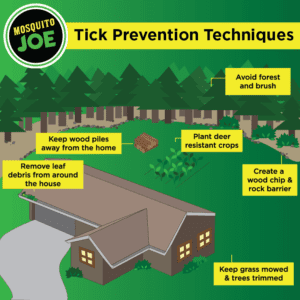With growing evidence that ticks can survive cold temperatures, these pests are becoming a year-round concern. As a result, even in the fall and winter months, it is crucial to understand the dangers posed by ticks and the most effective removal techniques.
How to Protect Yourself From Tick Bites
How to Protect Yourself From Tick Bites
- Know where ticks hide. Ticks live in tall grass and wooded areas. Hunting, gardening or spending time in your backyard are all activities where you, your family and your pets could pick up ticks.
- Dress to avoid ticks. Wearing long sleeves and long pants, tucking socks into boots and wearing light-colored clothing can help prevent tick bites.
- Utilize Mosquito Joe barrier treatments as an added layer of defense. Regular barrier treatments from Mosquito Joe eliminate ticks and give you and your family peace of mind.
![]() How to Conduct a Tick Check
How to Conduct a Tick Check
 Ticks can be as small as the tip of a pencil. They are usually hidden and difficult to find because they like to hide in warm places. Once you’ve returned indoors, check these areas for any remaining ticks.
Ticks can be as small as the tip of a pencil. They are usually hidden and difficult to find because they like to hide in warm places. Once you’ve returned indoors, check these areas for any remaining ticks.
- Under the arms
- In and around ears
- Inside the belly button
- Back of the knees
- In and around the hair
- Between legs
- Around the waist
Be sure to examine your outdoor gear and pets for ticks that may have latched on while you were outside. You can remove any attached ticks by placing clothing in the dryer for 10 minutes. Additionally, showering within two hours of being outside will help wash off unattached ticks and reduces the risk of contracting a tick-borne disease.
How to Effectively Remove a Tick
- Don’t panic! Grab a pair of tweezers with a fine tip. This will be the best tool to remove the small insect.
- Pull upward using steady, even pressure. Using this motion will ensure that the mouth-parts of the tick don’t break off and remain in the skin. If this does happen, use the fine-tipped tweezers to remove the mouth-parts.
- Clean the bite. Use rubbing alcohol or soap and water to clean your hands, the infected area and your tweezers.
- Dispose of the tick. Place the tick in alcohol, put it in a sealed container, wrap it in tape or flush it down the toilet. Don’t crush the tick between your fingers as it could still transmit disease.
- Following up: check on the bite. If you develop a rash, fever or any of the other symptoms associated with tick-borne disease, seek medical assistance. Tell your doctor about your recent tick bite, when the bite occurred and where you acquired the bite.
Know the Symptoms of Tick-borne Illness
Ticks are responsible for the transmission of numerous diseases. Knowing which ticks are common in your area can help you better understand the risks of various diseases. Most tick-borne illnesses cause fever, chills, aches, and pains. Many of the diseases, however, have different and distinct rashes. Knowing what to look for can assist you in detecting early symptoms of Lyme disease, Rocky Mountain spotted fever, southern tick-associated rash illness (STARI), or tularemia.
Call Mosquito Joe of Andover-Peabody today to add an extra layer of protection to your outdoor space and enjoy a bite-free yard! We offer special services that protect against ticks and other pests, so let us help you protect yourself and your family all year long.


